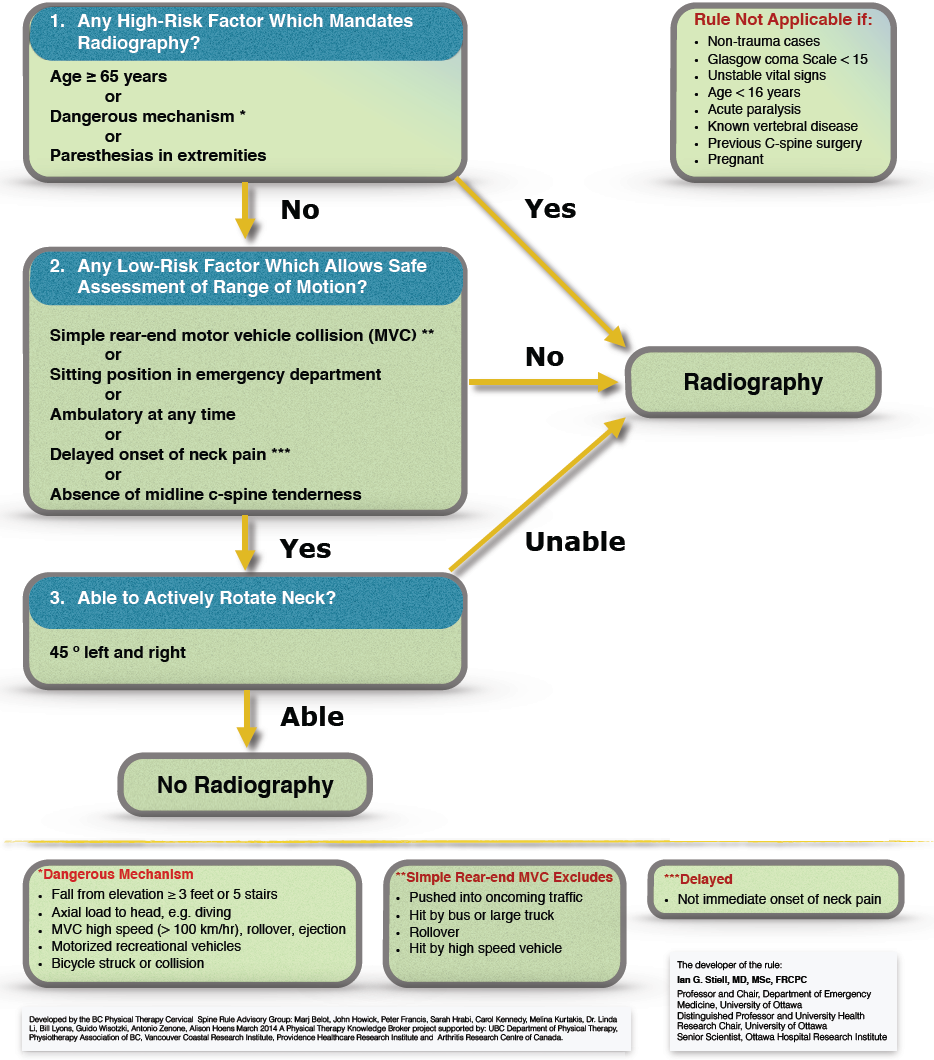management
Last edited 11/2019
-
at the initial visit practitioners should use the Canadian C-Spine Rule to:
- determine whether X-ray of the cervical spine is required for diagnosis
of fracture or dislocation and to avoid unnecessary exposure to X-rays
- Refer people at high risk of serious injury for cervical spine radiography
(1)
- Apply the Canadian C-spine rule in people aged 65 years or under to determine whether X-ray of the cervical spine is required for diagnosis of fracture or dislocation:
- Instructions for using the Canadian C-Spine Rule
- The Canadian C-Spine Rule is applicable to patients who are in an alert (Glasgow Coma Scale score of 15) and stable condition following trauma where cervical spine injury is a concern.
- It is not applicable in non-trauma cases, if the patient has unstable vital signs, acute paralysis, known vertebral disease or previous history of Cervical Spine surgery, or age <16 years.
- determine whether X-ray of the cervical spine is required for diagnosis
of fracture or dislocation and to avoid unnecessary exposure to X-rays
Schemata for Canadian C-Spine Rule (2):

- 1. Define whether any high risk factors are present such as age (>=65 years) or dangerous mechanism (includes high speed or roll over or ejection, motorised recreation vehicle or bicycle crash). If this is the case, an X-ray of the cervical spine should be performed.
- 2. Define low risk factors that allow safe assessment of neck ROM. If the low risk factors shown in the flow chart are not present, an X-ray of the neck should be performed.
- 3. Assess rotation of the neck to 45 degrees in people who have low risk factors shown in the QTF Classification of Grades of WAD. If people are able to rotate their neck to 45 degrees, they do not require an X-ray of the neck.
- This rule has been validated across several different populations and has been shown to have a sensitivity of 99.4 per cent and a specificity of 42.5 per cent. Essentially, physicians who follow this rule can be assured that a fracture will not be missed (95% CI 98-100%) (3).Further a systematic review investigated the diagnostic accuracy of the Canadian C-Spine Rule and the National Emergency, X-Radiography Utilization Study (NEXUS) criteria and found that the Canadian C-Spine Rule had better accuracy (4)
For NICE guidance relating to investigation criteria for neck injury then see linked item
Analgesia and patience are required.
- there is now overwhelming evidence that the use of collars in confirmed whiplash injury (neck sprain) prolongs the recovery of the patient. Patients should be advised about neck mobilisation and encouraged to start as soon as possible
- patients should be educated regarding posture advice regarding support of the neck whilst sleeping, and instruction about exercises
- patients with particularly severe symptoms or symptoms that are not resolving may benefit from physiotherapy
Reference:
- NSW. Guidelines for the management of acute whiplash-associated disorders for health professionals, third edition 2014
- https://www.physio-pedia.com/Canadian_C-Spine_Rule (Accessed 3/11/19)
- Stiell, I. G., C.M. Clement, R.D. McKnight, R. Brison, M.J. Schull, and B.H. Rowe, The Canadian C-spine rule versus the NEXUS low-risk criteria in patients with trauma. New England Journal of Medicine, 2003. 349(26): p 2510-2518.
- Michaleff, Z.A., C.G. Maher, A.P. Verhagen, and T. Rebbeck, Accuracy of the Canadian C-spine rule and NEXUS to screen for clinically important cervical spine injury in patients following blunt trauma: a systematic review. Canadian Medical Association Journal. 2012. 184(16): p. E867-E76
investigation of a neck injury
assessment for cervical spinal injury - Canadian C - spine rule